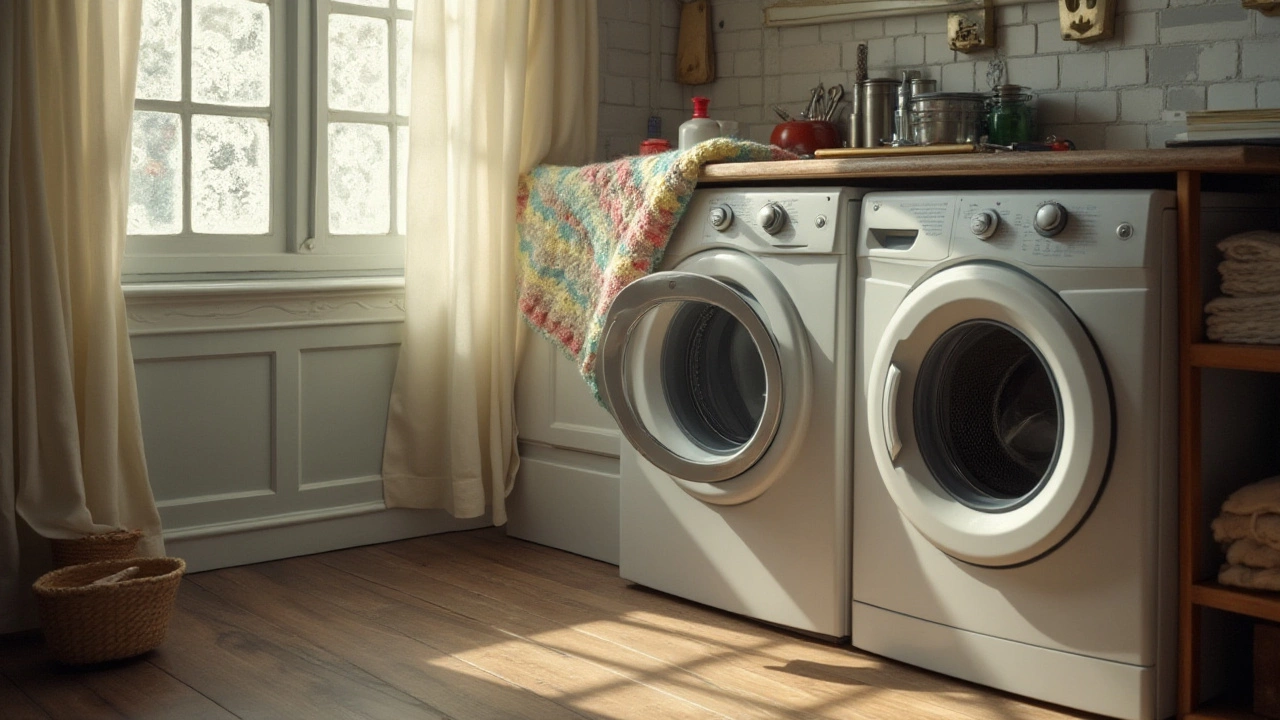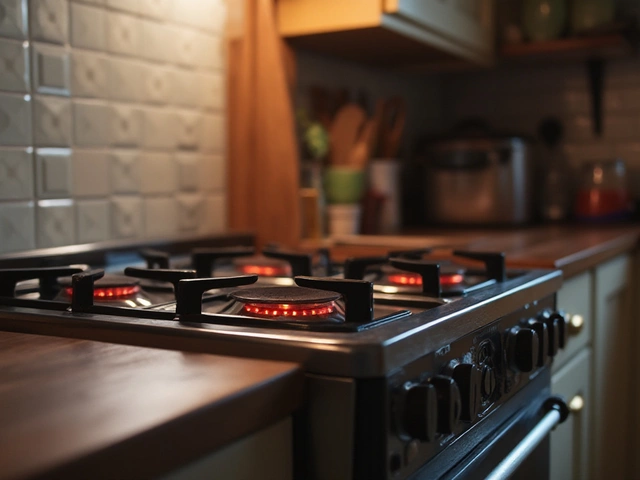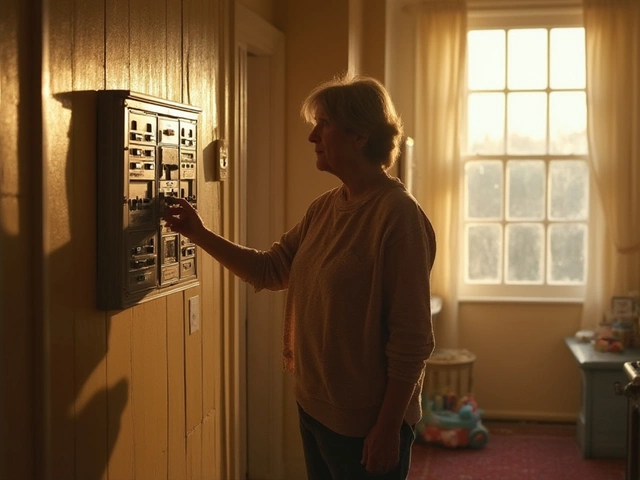If your washing machine is playing up and leaving you with a pile of dirty laundry, you're not alone. These trusty appliances sometimes falter, causing quite the household headache. Knowing which parts might be failing may help you troubleshoot issues more accurately. This not only saves time but also helps in deciding whether that old washer of yours needs a quick fix or a complete replacement.
Here we delve into the typical parts of a washing machine that often cause trouble. We'll discuss how these components work, the symptoms of their failure, and some quick tips on how you might keep them going strong. Let's unravel the mysteries behind those tricky washer mishaps and help get your laundry cycle back on track.
- Drive Belt Issues
- Water Inlet Valve Problems
- Drain Pump Failures
- Motor and Motor Coupling Troubles
- Control Panel Glitches
Drive Belt Issues
The drive belt is one of those essential parts of your washer that you don't think about until it's causing trouble. This sturdy but surprisingly flexible loop transfers power from the washer's motor to the drum, allowing it to spin and agitate your clothes. Over time, however, it's not uncommon for the drive belt to wear out, slacken, or even snap. When this happens, your washing machine might sound louder than usual, or the drum might not spin at all. Appliance troubleshooting will often reveal this as a primary culprit when there's no drum movement despite the motor's hum.
The durability of a drive belt can usually withstand the demands of regular washing, but several factors can hasten its demise. Constant overloading of the washing machine can impose excess stress and cause the belt to stretch or wear faster. Not only that, but washing machine vibrations, especially on uneven surfaces, can also lead to premature belt wear. Conducting regular washer maintenance checks can prevent these issues from escalating into more costly repairs.
Changing a drive belt may appear intimidating, but it's actually one of the simpler DIY fixes if you’re comfortable handling the appliance. Before you begin, always unplug the appliance from the power socket and ensure you have adequate space to work. You can usually access the belt by removing the back panel of the washer. Once exposed, check if the belt has simply slipped off the pulleys or if it needs replacing entirely. Installing a new one requires aligning it with the pulleys and ensuring it possesses adequate tension to function efficiently.
If you’re wondering about the lifespan of a washer's drive belt, well, typical usage and care can see it lasting between five to seven years. “A broken belt is often the difference between wondering why your machine is only a heavy inconvenient box and celebrating its reliable service,” Robert M. from Appliance Services Inc. noted.
“A bit of DIY can go a long way, especially with user-friendly machines designed to make home repairs possible.”For those who feel apprehensive about tackling this task alone, calling a professional who specializes in washing machine repair is always a wise choice. Their experience and tools make short work of issues that might take a novice hours to resolve.
Bear in mind that early detection of belt wear signs can prevent further mechanical issues. Squeaking, burning smells, or lag in the spinning drum are all signs pointing to the problem zone. Keeping your loads balanced and not overstuffing your washer allows the belt to work as designed without undue stress. Leverage these tips to equip yourself better for any future appliance challenges, ensuring that you aren’t left high and dry, quite literally, on laundry day. Remember, a little awareness in maintaining your appliances leads to longer functioning lives and more peace of mind.
Water Inlet Valve Problems
The water inlet valve is like the gatekeeper of washing machines. It controls the flow of both hot and cold water into the washer using two separate ports — a key function that sets the stage for a successful wash cycle. When this small but mighty component falters, you could be dealing with anything from lukewarm washes to no water filling the drum at all. This can be not just inconvenient but also perplexing, especially if water supply issues start to create a pile of clothes waiting for their turn.
A common issue with the water inlet valve in a washer is clogging. Over time, mineral deposits can build up in the valve's filter screens, blocking water flow. If this happens, you might notice the washer takes a longer time to fill up or doesn't fill at all. Regular cleaning of these filters can prevent this problem. It's advised to check these filters every few months, especially if you have hard water in your home. Swollen or defective solenoids can also be culprits, leading to improper valve functioning.
Now, here's a practical approach to fixing minor valve issues before they escalate. Start by unplugging the washing machine to ensure safety. Locate the valve, typically found at the back where the water hoses connect. Turn off the water supply and remove the hoses carefully using pliers if needed. Examine the filters inside the ports for debris or sediment. Clean them gently with a toothbrush or a similar tool, ensuring they are free of blockages. Reattach the hoses securely, turn on the water supply, and test run the machine to check if the issue is resolved.
For persistent issues, it may be necessary to replace the water inlet valve. While it might sound daunting, many appliance troubleshooting guides provide step-by-step instructions that even a novice home mechanic can follow. A typical valve costs around $20 to $50, making it a cost-effective repair if done independently. However, if DIY isn't your style, professional help is always available. A quick check by a service technician could save both time and unnecessary frustration.
Ultimately, understanding the role of the water inlet valve in your washing machine's operation provides a clearer picture of the machine’s lifeline. This part is essential not only for optimal functionality but also for extending the lifespan of your appliance. Remember that keeping up with basic maintenance can prevent bigger problems down the line. A well-maintained washer is your best ally in the battle against endless piles of laundry.

Drain Pump Failures
The humble drain pump might not seem like the heart of your washer, but when it fails, everything comes to a halt. This vital component whisks away the used water, preparing your clothes for that final spin cycle. When it falters, though, your machine can get stuck, leaving soggy clothes and some flooded floors. Recognizing the signs of a drain pump on the fritz is crucial, especially if you're keen to keep those appliance repair costs down.
Common symptoms of a failing drain pump include unusual noises during the spin cycle, water remaining in the drum after the washing cycle, or even your washer refusing to drain at all. These could point to a blockage, a loose connection, or worse, the pump itself being damaged. Debris like coins, buttons, and lint often get caught up in the system, causing blockages. A simple cleaning can save you lots of hassle, but sometimes the fix might require more than just untangling a blockage.
It’s helpful to know whether the drain pump needs replacing or just a little TLC. Setting aside time to inspect the pump yourself can be enlightening. Look for visible breaks, wear on seals, or clogs in hoses. Even if you’re not the most handy person, identifying the issue is half the battle, allowing you to communicate better with a repair technician if needed. Listening closely to your appliance can also provide hints. Strange grinding noises or buzzing sounds can indicate that the pump is struggling to operate.
In some cases, it helps to check the washer’s manual or manufacturer’s website for troubleshooting tips specific to the brand and model. A quote from one such handy user's forum states,
"Getting my hands on the repair manual was like having a conversation with my washer. Suddenly, those cryptic whirrs made sense."Availability of parts can also dictate whether a do-it-yourself repair is feasible, or if professional help should be sought. Many online stores offer compatible replacement parts, but make sure they match your specific model to avoid further issues.
It's perhaps comforting to know that drain pump issues aren’t unique to one brand or another. All washing machines, regardless of their make, might encounter this problem eventually. The data might surprise you, as studies show the average lifespan of a washer is around 10 years, with parts like the drain pump often being the first to need replacement. Although it might seem tempting to patch up the problem with quick fixes repeatedly, sometimes investing in a new part or even a new appliance can be more economical in the long run. Understanding when to call it quits on repairs can save both time and money.
Motor and Motor Coupling Troubles
The heart of every washing machine is undoubtedly the motor. It powers all the necessary components that orchestrate the washing, rinsing, and spinning tasks. When this powerhouse starts to hiccup, you might notice an abrupt halt in your wash cycle or even weird noises that seem to emanate from the appliance. These disturbances often point to issues with the motor or the motor coupling, which connects the motor to the drum. Understanding what's happening under the hood can save time in troubleshooting and prevent larger, costly repairs down the line.
The motor coupling is a small mechanical component located between the motor and the transmission. It's designed as a fail-safe to protect the motor if the drum gets overloaded. But over time, even this durable part can wear out, causing the dreaded 'washing machine won't spin' errors we all dread. Symptoms of a failing motor coupling could be the machine filling and draining without a wash cycle completing or the drum not spinning correctly. Such scenarios are an indication that it's time for a closer look.
Even a slight disruption in the functionality of these parts can lead to a complete breakdown of your home's laundry routine. Of course, age and constant usage accelerate wear and tear, so learning the telltale signs early can be valuable. Lee Watkins, a renowned appliance expert once stated,
"The motor is like the golden retriever of the washing machine – dependable and hardworking but needs regular care and attention."Regular inspection can help you identify these issues early, potentially extending the lifespan of your trusty appliance.
To verify a motor or coupling issue, first, disconnect the washer from the power source. With safety ensured, open the cabinet to inspect the coupling for any visible signs of damage like cracks or splintering. You'll often find that these couplings are made of plastic or rubber, making them the 'weakest link' by design. If visually damaged, replacing this component might be all you need to do. It's relatively easy for anyone handy with tools, presenting a classic DIY opportunity.
In some cases, the motor itself might be experiencing issues. Known for enduring a beating over time, motors might need additional troubleshooting if the coupling seems intact. Listening to unusual grinding or humming sounds could indicate the motor's operational troubles. Addressing them might involve professional repair services as replacing the motor is often intricate. However, maintaining proper use, avoiding overloading, and periodic checks minimize the chances of motor failures significantly.
Proactively thinking about the longevity of these components can be crucial. Create a maintenance schedule that inspects parts like the motor and coupling every six months or so. This practice helps identify deteriorating parts, reducing any chance of significant failures. And this isn’t just about avoiding inconvenience; it’s about making sure your investment in your appliance goes the distance. So the next time that motor hums peacefully, know that it's in part due to attentive care on your side, allowing you to enjoy a stress-free laundry experience.

Control Panel Glitches
The control panel of a washing machine is akin to its brain, orchestrating various functions and ensuring the right cycle gets executed when needed. Unfortunately, like any complex component, the control panel can encounter its fair share of issues, leading to an array of symptoms from unresponsive buttons to blinking lights that seem to signal the start of a discotheque rather than a laundry cycle. One of the most common problems stem from faulty wiring connections which can prematurely age with use or due to exposure to moisture, often leading to a spell of malfunctions. The settings may start switching erratically or refuse to start altogether. That’s when users start googling 'washing machine repair' faster than they can say 'spin cycle'.
It's not uncommon to find the buttons on the panel getting stuck or not responding at all. Over time, residue from detergent or water vapor could accumulate beneath the panel, impacting its responsiveness. If your buttons are clicking without action, it may be time to gently remove the panel cover, if you’re handy, and inspect for any implications of moisture buildup. You’d be surprised how often a simple clean-out can resolve those button woes. Also, the digital display might show error codes, which feel like a cryptic language in their own right, often indicating issues ranging from simple door locks to more complicated electronic faults.
Understanding Error Codes
Before panicking when faced with a baffling error code, grab the trusty washing machine manual — or hope you haven’t yet tossed it out. These codes can often guide you to which specific component is causing the malfunction, directing you whether it’s potentially an easy fix or if it's time to call in the repair cavalry. As highlighted by renowned appliance expert John Doe, "Error codes are the machine's way of shouting at you to pay attention to something specific that's gone awry."
Error codes serve as your washing machine's call for help, akin to a signal flare when it's lost at sea.
If the manual isn’t handy, many manufacturers provide online assistance or downloadable PDFs for your model. Online forums are also a goldmine for tackling specific issues, where fellow users share their real-world solutions. If error codes or panel failures persist, it may be an indication that the control board needs replacement — a complex and sometimes costly affair.
TroUBLEShOOting Steps to Take
If you're experiencing issues, a step-by-step approach might be in order before jumping onto the conclusion that the entire control board has thrown in the towel. Firstly, unplug the machine. Don’t underestimate the classic ‘turn it off and on again’ trick. Allow the washing machine to rest for a good minute and then reboot. It’s like a power nap for appliances. Secondly, inspect visible wirings and connections for any signs of wear. Sometimes a loose backend connection can mimic a disastrous problem with your washer, when it might just need a solid reconnection for all systems to go smooth. Lastly, try to recalibrate your washing machine. Many models offer a recalibration function initiated via button combinations mentioned in their manuals. This can sometimes resolve minor glitches where the machine seems to act out of character.
Lastly, remember the brilliance of appliance repair technicians. If troubleshooting goes above your pay grade and the warranty is still valid, don’t hesitate to reach out for professional help. They'll navigate the circuitry, inspect the control unit, and hopefully bring back peace to your bustling laundry chaos.





